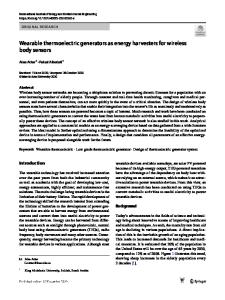Preparation of polyaniline/graphene coated wearable thermoelectric fabric using ultrasonic-assisted dip-coating method
- PDF / 2,259,217 Bytes
- 12 Pages / 595.276 x 790.866 pts Page_size
- 24 Downloads / 358 Views
(2020) 9:21
ORIGINAL PAPER
Preparation of polyaniline/graphene coated wearable thermoelectric fabric using ultrasonic‑assisted dip‑coating method Reza Amirabad1 · Ahmad Ramazani Saadatabadi1 · M. Hossein Siadati2 Received: 1 August 2020 / Accepted: 19 September 2020 © The Author(s) 2020
Abstract The use of thermoelectric fabrics for powering wearable devices is expected to become widespread soon. A thermoelectric fabric was prepared by coating nanocomposite of polyaniline/graphene nanosheets (PANI/GNS) on a fabric. Four samples of the fabric containing different wt% of GNS (0.5, 2.5, 5, and 10) were prepared. To characterize the samples, Fourier transform infrared (FTIR) spectra, attenuated total reflectance-Fourier transform infrared (AT-FTIR) spectra, field-emission scanning electron microscopy (FE-SEM), electrical conductivity and Seebeck coefficient measurements were used. The electrical conductivity increased from 0.0188 to 0.277 S cm−1 (from 0.5 to 10 wt% of the GNS in PANI/GNS nanocomposite). The maximum coefficient of Seebeck was 18 µV K−1 with 2.5 wt% GNS at 338 °C. The power factor improvement was from 2.047 to 3.084 μW m−1 K−2 (0.5–2.5 wt% GNS). Graphic abstract
Keywords Thermoelectric · Nanocomposite · Graphene · Conductive polymer · Polyaniline
Extended author information available on the last page of the article
13
Vol.:(0123456789)
21
Page 2 of 12
Introduction Considering the population growth and significant increases in welfare of most populated countries, the energy crisis has become an ever more crucial phenomenon. There are several solutions to this crisis such as solar cells, biomass, wind, and so on [1]. Another solution involves recycling of waste energies and inventing energy-harvesting technologies that can harvest various forms of energy from the environment dynamically and convert it to electricity. Recently, piezoelectric and thermoelectric materials have been used in this regard. For instance, as the Internet of Things (IoT) becomes more popular, the need for advance sensors will also become more and more crucial [2–4]. Most of the waste energy is basically the thermal energy from factories, transportation vehicles and residential units. Thermoelectric materials can convert heat to electricity directly. This phenomenon was first observed by Seebeck in 1821 [5], and is characterized by the formula ZT = S2σT/κ, where S, σ, κ and T, stand for Seebeck coefficient, electrical conductivity, thermal conductivity, and absolute temperature, respectively [6]. Another method to describe thermoelectric property is the power factor (PF = S2σ) [7]. As in semiconductors, the thermoelectric materials are also divided into two types; n-type and p-type. In the n-type thermoelectrics, the current generation results as the electrons move to the cold side, while in the p-type, the current generation takes place as the holes move to the cold side. Among the most important inorganic materials that have ever been used in thermoelectrics are Bi2Te3, PbTe, GeTe, and Sb2Te3 [8–13]. However,
Data Loading...











